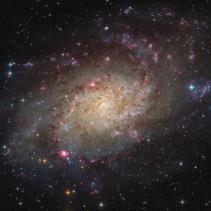Reply to comment
M 33
The Triangulum Galaxy is a spiral galaxy approximately 3 million light-years (ly) from Earth in the constellation Triangulum. It is catalogued as Messier 33 or NGC 598, and is sometimes informally referred to as the Pinwheel Galaxy, a nickname it shares with Messier 101. The Triangulum Galaxy is the third-largest member of the Local Group of galaxies, which includes the Milky Way, the Andromeda Galaxy and about 44 other smaller galaxies. It is one of the most distant permanent objects that can be viewed with the naked eye.
The galaxy is the smallest spiral galaxy in the Local Group and it is believed to be a satellite of the Andromeda Galaxy due to their interactions, velocities and proximity to one another in the night sky. It also has an H-II nucleus.
The Triangulum Galaxy was probably discovered by the Italian astronomer Giovanni Battista Hodierna before 1654. In his work De systemate orbis cometici; deque admirandis coeli caracteribus ("About the systematics of the cometary orbit, and about the admirable objects of the sky"), he listed it as a cloud-like nebulosity or obscuration and gave the cryptic description, "near the Triangle hinc inde". This is in reference to the constellation of Triangulum as a pair of triangles. The magnitude of the object matches M33, so it is most likely a reference to the Triangulum galaxy.
The galaxy was independently discovered by Charles Messier on the night of August 25–26, 1764. It was published in his Catalog of Nebulae and Star Clusters (1771) as object number 33; hence the name M33. When William Herschel compiled his extensive catalogue of nebulae, he was careful not to include most of the objects identified by Messier. However, M33 was an exception and he catalogued this object on September 11, 1784 as H V-17.
L = 19 * 1800 sec. bin1, RGB = 10 * 900 sec. bin2, HaOIII = 11 * 1800 sec. bin2, in the each filters.
Total exposition - 28 hours.
Pixinsight 1.8, Lightroom.

